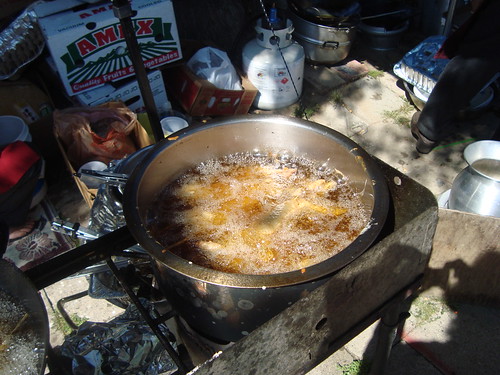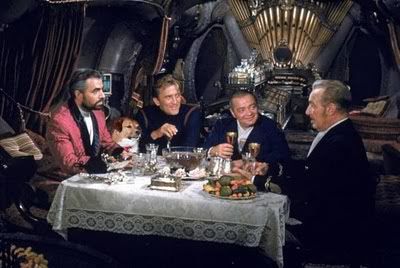
Over the Thanksgiving weekend, I found myself discussing the UNESCO Creative Cities Network that is designating various cities as model examples of different art forms, and also had a fun twitter conversation on what Southeast Asian Steampunk cuisine would look like.
Addressing the UNESCO Creative Cities network concept, what we saw were the usual forms you'd expect: Literature, film, music, crafts and folk art, design, media arts, and what I thought was particularly interesting, gastronomy.
Before we go too much further, I should note that I'm also a fan of cryptogastronomy: the consideration of hypothetical recipes for mythic, theoretical and extinct species of flora and fauna. How might you pair a good wine with a 18th century Triceratops filet in the Lost World, for example?

But back to our subject.
I can find people showing me what theoretical steampunk ray guns and artificial wings look like, no sweat. We can now also find several Steampunk musical bands such as Steam Powered Giraffe:

But what's the Steampunk response to cooking?
A UNESCO Creative City of Gastronomy celebrates a city that finds a way to preserve local know-how, traditional culinary practices and methods of cooking that have survived industrial/technological advancement.
If you have a retrofuture, those guidelines become a very interesting question. But this is a subject that most novels and stories in a steampunk world give only passing consideration to before we rush off to battle air pirates and mad scientists.
It often feels we're in a rush to finish the meal, and the conversations are more important than what's being served, the where and the how, in a steampunk story. But these can matter. (Or anti-matter, depending on the science employed in the setting.)
When you've got so much heat being given off by steam engines and other technology, surely this creates both challenges and opportunity with cooking and dining practices.
There are a few exceptions to the artistic exploration of steampunk cooking, such as Fuel for the Boiler: A Steampunk Cookbook, and of course the steampunk cakes that suggest in the retrofuture, people would employ motifs that reflect what's surrounding them such as gears and cogs.

We see many dining scenes in classic steampunk films such as Atlantis: The Lost Empire, 20,000 Leagues Under the Sea, and Steamboy, just to name a few, but little consideration for what's practical and possible in a steam-powered diet, and how that would affect characters' health, habits and societies.
Most of the dishes we've seen proposed in the genre have explored it from a distinctly European-American perspective, but I think there's a good deal to be learned from examining how Asian nations would embrace cooking in a steampunk world.
For Asian nations in a steampunk world, there's a wide range of dishes that they would enthusiastically adapt to take advantage of high-powered, high-temperature steam technology. Rice steaming, dumplings and other dim sum staples immediately come to mind. So do steamboats and hot pots.
Would certain cultures gain advantages in being able to produce large amounts of food for their crews and entourages quickly? How might they view something like a slow-cooked barbecue?
When you have the ability to steam something within seconds rather than hours or minutes, you've reduced cooking time and you might get more time to talk with your guests at the dinner table if you're the cook. But it might work the other way: You face conversations that are very rushed because you're not waiting long together for the food to finish cooking after you've placed your order.
Will ingredients be chosen for their ability to be steamed quickly, or those that take longer to steam well? Will those that don't lend themselves well to steaming gradually fall by the wayside? Which substances will be stored aboard ships for their versatility, or despised for being excessively soluble in water?
Addressing the UNESCO Creative Cities network concept, what we saw were the usual forms you'd expect: Literature, film, music, crafts and folk art, design, media arts, and what I thought was particularly interesting, gastronomy.
Before we go too much further, I should note that I'm also a fan of cryptogastronomy: the consideration of hypothetical recipes for mythic, theoretical and extinct species of flora and fauna. How might you pair a good wine with a 18th century Triceratops filet in the Lost World, for example?

I can find people showing me what theoretical steampunk ray guns and artificial wings look like, no sweat. We can now also find several Steampunk musical bands such as Steam Powered Giraffe:

But what's the Steampunk response to cooking?
A UNESCO Creative City of Gastronomy celebrates a city that finds a way to preserve local know-how, traditional culinary practices and methods of cooking that have survived industrial/technological advancement.
If you have a retrofuture, those guidelines become a very interesting question. But this is a subject that most novels and stories in a steampunk world give only passing consideration to before we rush off to battle air pirates and mad scientists.
When you've got so much heat being given off by steam engines and other technology, surely this creates both challenges and opportunity with cooking and dining practices.
There are a few exceptions to the artistic exploration of steampunk cooking, such as Fuel for the Boiler: A Steampunk Cookbook, and of course the steampunk cakes that suggest in the retrofuture, people would employ motifs that reflect what's surrounding them such as gears and cogs.

We see many dining scenes in classic steampunk films such as Atlantis: The Lost Empire, 20,000 Leagues Under the Sea, and Steamboy, just to name a few, but little consideration for what's practical and possible in a steam-powered diet, and how that would affect characters' health, habits and societies.
Most of the dishes we've seen proposed in the genre have explored it from a distinctly European-American perspective, but I think there's a good deal to be learned from examining how Asian nations would embrace cooking in a steampunk world.
For Asian nations in a steampunk world, there's a wide range of dishes that they would enthusiastically adapt to take advantage of high-powered, high-temperature steam technology. Rice steaming, dumplings and other dim sum staples immediately come to mind. So do steamboats and hot pots.
Would certain cultures gain advantages in being able to produce large amounts of food for their crews and entourages quickly? How might they view something like a slow-cooked barbecue?
When you have the ability to steam something within seconds rather than hours or minutes, you've reduced cooking time and you might get more time to talk with your guests at the dinner table if you're the cook. But it might work the other way: You face conversations that are very rushed because you're not waiting long together for the food to finish cooking after you've placed your order.
Will ingredients be chosen for their ability to be steamed quickly, or those that take longer to steam well? Will those that don't lend themselves well to steaming gradually fall by the wayside? Which substances will be stored aboard ships for their versatility, or despised for being excessively soluble in water?

Might we see flash-banquets emerge as an art-form, where chefs are challenged to create the most intriguing repasts that can be prepared with a set of steamers? Steam Iron Chef, if you will...
But for an underclass, this could lead to shorter meal-times and longer workdays. "What do you need a half-hour for? It takes a minute to make your soup and sandwich. You get five minutes, then back to the machines."
Especially in the industrial dystopias of steampunk, where life is nasty, brutish, short and hot, meals and how we take them have a way of sending messages within a culture and across cultures. Hopefully, some authors will take those into deeper consideration during their world-building process.
5 comments:
You should have copied-pasted a transcript of the little chat you, Joyce and I had!
Anyway, at Steampunk Nusantara, we actually have a few entries for food we might find in a SEAsian steampunk world. I had a lot of fun writing them.
Lol. Probably. There were definitely a lot of great points we could jump off with. It occurs to me one day it might be interesting to examine: Alternate food history. What if Italy hadn't adopted pasta from the Chinese? or: "Oops, they brought a batch of nightshade, not tomatoes from the New World..."
I explore this very topic over at my blog, and the only reason that my cuisine tends towards the Western is that those are the sources I have on hand—in fact, the only two non-Western cookbooks I can find from the 19th/early 20th century that are not in an original language are one written about Curry by an Indian servant in England, and an early 20th century Chinese cook book from California, which is essentially the granddaddy of takeout "Chinese" food (featuring about 100 different ways to make Chop Suey.)
Also, your triceratops is likely to be similar to a modern ruminant, with slightly lighter and "fishier" flesh based on its being a reptilian creature; I'd sat for a Triceratops Steak, seasoned with salt and pepper and grilled, a nice big red wine, slightly acidic—something like a Chianti—would be a good choice. But that's just me, your palate may vary.
For the Lao community, we're fortunate to have the translation of Phia Sing's Traditional Recipes of Laos and ca. 114 recipes to consider. I'll have to take a new look at which ones really suit themselves towards consideration in a steampunk world.
As for the Triceratops steak, I'm seeing a number of marinades proposed for critters like alligators including a milk marinade surprisingly: Place milk in a deep bowl, add pepper flakes and rosemary. Season the meat with black and cayenne peppers. Place meat in the bowl, add milk and cover. Let marinate 3-4 hours. Voila, at least if you like it Southern style...
This was an excellent read! XD
Post a Comment